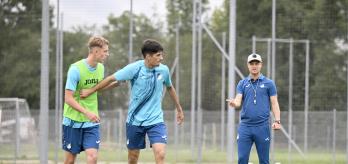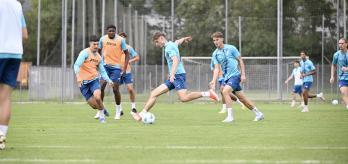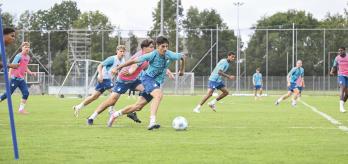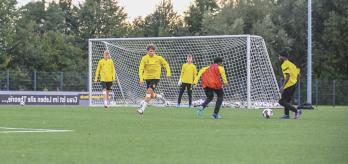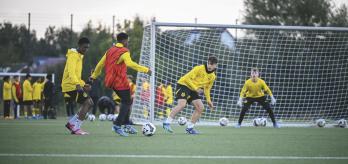The first drill is designed to work on attacking and defensive tactics at the same time. The second exercise is primarily aimed at midfielders and strikers, while the third pushes the players to defend their goal at all costs by giving the opposition a numerical advantage. The idea is to send the message that if you can work together effectively as a defensive line, you can always defend your goal, even if you are short-handed. Finally, another intense drill simulates just about every scenario that might crop up during a game.
Build-up against a high press in tight spaces
This little game form serves to hone defensive and attacking tactics at the same time – without the players even noticing what is being worked on! From a defensive point of view, it teaches them how to operate in a back four behind a defensive midfielder/number 6. Specifically, they learn how to work as a defensive line and link up with the player in front of them. For the team in possession, the drill represents a challenge for the midfield four and the strikers. Their job here is to break lines, which is one of the most important areas to focus on when it comes to creating chances. They need to work out when and where the space will open up in the defensive line, and spot the perfect moment to make the run in behind. These tactical details are decisive, but the exercise also incorporates a period of free play, so there is no shortage of fun, either.
-
First, mark out a 30m x 35m playing area. Set up a full-size goal at each end of the area, each guarded by a goalkeeper. Then mark a halfway line (which doubles as an offside line) as shown.
-
Form 2 teams of 6 players (including the goalkeepers).
-
The attacking team should set up in a 2-3 formation, with the defenders in a 4-1 shape.
-
Play a 6v6 game.
-
The offside rule applies.
-
The defenders should set themselves up on the halfway line. Only one of the four defenders can come off the line at any one time to work alongside the defensive midfielder (number 6).
-
Every time possession changes hands, the coach passes another ball onto the pitch and the teams play as they please for 45 seconds, with no offside rule.
-
Emphasise the need to shift across depending on where the ball is.
-
Whenever a defender leaves the line, their team-mates have to cover the gap.
-
Encourage players to sprint in behind as soon as the player in possession has the ball in space and is ready to play the pass.
-
Help players recognise and exploit the gaps in behind the opposition lines.
Find/protect the red zone
This exercise is primarily aimed at the midfielders and strikers. In a lot of teams, these units tend to come up short defensively. One way of defending in a back four is to push forwards. However, the risk of doing that is that you leave gaps behind you, and the players have to be scanning constantly to see what is happening up ahead and behind them. From an attacking point of view, the idea is to find the neutral players between the lines. That is where your central midfielders (number 8s), playmakers and strikers should be operating, because having players in these positions who can inject pace into the attack and push to get shots on goal is absolutely pivotal. For the players in possession, the important thing is to press as soon as they lose the ball.
-
Mark out a 30m x 18m playing area. Then draw three lines across the middle of the marked area as shown, thus forming a two-part “red zone” stretching 2.5m into each half. Finally, set up a full-size goal at each end of the playing area, each guarded by a goalkeeper.
-
Form 2 teams of 5 players, and nominate another 2 neutral players.
-
Position the players as shown in the diagram.
-
The attacking team (shown in blue) start 5v1 in their zone, and should aim to get the ball to one of the neutral players in the section of the “red zone” closest to the other end of the pitch.
-
The defenders should set themselves up on the halfway line. Only one of the four defenders can come off the line at any one time to work alongside the defensive midfielder (number 6).
-
Once the ball comes through to them, the neutral players should work together to beat the goalkeeper.
-
If they win the ball, the defenders should counter-attack towards the goal.
-
Once a goal is scored, the other team get to attack, and the neutral players should move into the opposite section of the red zone (i.e. they change ends).
-
Play always starts from the relevant goalkeeper.
-
A couple of the defenders should hunt the ball down in the opposition half.
-
Depending on what is going on in the game, the defenders in the middle zone should shift across as necessary, while keeping an eye on the neutral players behind them.
-
Players should look for opportunities to bring the neutrals into play, and exploit them effectively when they find them.
-
The neutrals should be adjusting their positions constantly so that they can stay open and ready to link up with their team-mates.
-
When they get the ball, the neutrals should get moving as quickly as possible and look to get shots on goal.
Final third attacks v defensive principles
This game form has accompanied Dortmund's U17 throughout the season. Making players defend when outnumbered fosters the determination to do whatever it takes to protect the goal. This exercise is designed to get the message across that if you work together as a defensive unit, your line won’t crumble, even when you are outnumbered, and you can still protect your goal. Teams in possession often find themselves dealing with opponents who are determined to sit deep and “park the bus” in front of their own penalty area. When you are faced with that situation, you have try to break the deadlock, but you also have to be wary of a counter-attack if you lose the ball, which is why you need to be equipped with a well-organised rest defence. If you have that, it gives the players around the ball the freedom to be brave and aggressive in their counter-press.
-
On a full-size pitch, mark out a 45m-long playing area. Then position two full-size goals and four mini-goals in the playing area as shown.
-
Form an attacking team (shown here in blue) of 11 players (including a goalkeeper), and a defending team (shown in red) of 7 players (including a goalkeeper).
-
The blue team should play in a 4-3-3 formation, and red should set up in a 4-2 shape.
-
Play starts with the blue team’s goalkeeper.
-
Play a game of 11v7.
-
The offside rule applies.
-
If they win the ball, the defenders can counter-attack towards the full-size goal or either of the mini-goals.
-
The defenders will need to shift across as a unit to defend the goal.
-
If the ball goes out wide, the full-backs push out, and the other players in the back four occupy the “golden zone”.
-
If a central midfielder/number 8 runs in behind, it is down to the closest midfielder to pick them up. If need be, the central defender nearest the ball can push out to help.
-
Encourage players to push up whenever the opposition pass backwards.
-
The team in possession should be mindful of what might happen if they lose it, and make sure that they are in a compact shape behind the line of the ball.
-
The team should counter-press as soon as they lose the ball.
-
The goalkeeper should be coaching the players in front of them through the game.
-
Assuming there are equal numbers, the last line of defence should go player-to-player in a rest defence set-up.
The Intensity Game
This game form, frequently used by Jürgen Klopp at Liverpool FC, covers all the bases. To succeed, the team in possession will need to break down an opposition sitting deep, at the same time as making sure that their rest defence is effective at all times. The exercise also gives them plenty of opportunity to practise their counter-press. Meanwhile, the defenders need to focus on sitting deep and protecting their own goal. As soon as the attackers shoot off target, the roles are reversed, and the defenders take on the challenge of building up their play in the face of an aggressive high press. This is an exciting, high-intensity exercise that pushes the players to their limits.
-
Mark out a 55m-long playing area that is the same width as the penalty area. Then mark lines across the playing area to divide it into three zones (22m/11m/22m long, respectively). Finally, set up a full-size goal at each end of the playing area as shown, each guarded by a goalkeeper.
-
A coach should be stationed pitchside between the two offside lines, with a supply of balls.
-
Form 3 teams of 5 players and position them as shown in the illustration.
-
Start playing 5v5+GK in one half of the playing area.
-
The offside rule applies for the attacking team.
-
Every time the attacking team get a shot on target away (regardless of whether they score or the goalkeeper saves it), the coach plays a ball in to the attackers from the touchline.
-
When the ball goes out of play over the goal line, the relevant goalkeeper restarts play. The team that were defending get possession, and they try to get the ball into the middle zone.
-
If they succeed, they go on to attack the goal at the other end of the pitch, playing 5v5+GK.
-
If the defending side win the ball, they should counter-attack and try to get the ball forward into the middle zone themselves. If they succeed, they carry on the attack in the other half of the pitch, playing 5v5+GK.
-
Players can only enter the middle zone by dribbling the ball into it.
-
Then have the attackers and defenders swap roles.
-
The team in possession need to get a shot away before they lose the ball.
-
Teams will need to maintain an organised rest defence away from the ball, and press aggressively around the ball.



